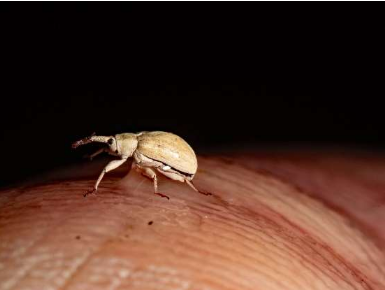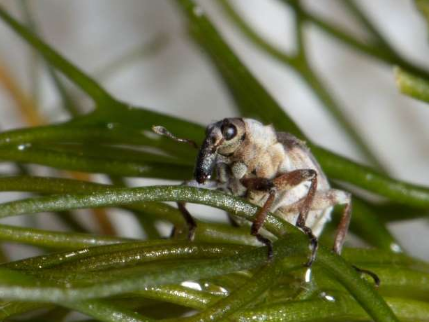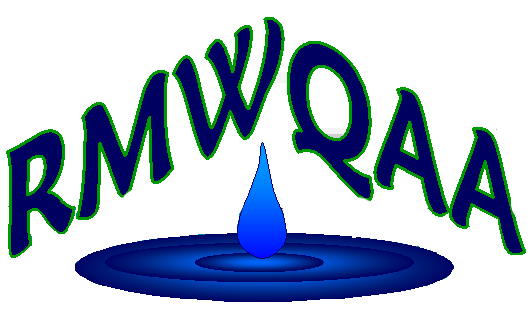We’ve had a major success in our Milfoil Weevil program. Some of the preliminary results are shown in cute pictures from Bob Krugmire – see below!
When we talk about the Standley Lake Weevils – it’s often with a lighthearted tone. They’ve got names like Wilber and Wilma Weevil. We joke about our new job titles of weevil farmers – definitely atypical water utilities work. And a couple of us even have stuffed animal weevils. (Note – if anyone is looking for a good Christmas present for me…I want one.)
But in truth, this is so much more than a fun pastime. This program represents what our Westy team excels at: Seeing the big picture, getting to the root of a problem, and finding the right solution – even if it’s far outside the box. And – we’re not afraid to get our hands dirty and try new things in the process.

Figure 1 - Mature Weevil on fingertip.
Many entities treat their water supplies with chemicals to keep algae and other unwanted contaminants at bay. Here at Westminster though, we have an entirely different approach. We work hard to keep our water supply clean and healthy to begin with – so that those expensive and unhealthy chemical treatments aren’t necessary. The health of Standley Lake’s ecosystem is the basis of our raw water supply program - Mother Nature is one of our best tools in the effort to maintain exceptional water quality. And through decades of hard work, Standley Lake is now one of the best source waters in the State. Seriously.
A healthy lake ecosystem results in cleaner source water. Clean source water results in substantially reduced water treatment costs. It reduces unhealthy treatment residuals in our drinking water and results in better tasting water for our customers.
But Standley Lake does have a health issue that staff works hard to mitigate - an invasive species called Eurasian Milfoil. This milfoil chokes out native plants, reduces biodiversity, and ultimately increases the potential for blue-green algae blooms (which can cause taste/odor issues and can release cyanotoxins which are extremely dangerous). Additionally, beds of milfoil will create areas of low oxygen that can increase the release of nutrients, sulfur, and even metals from the soils.
Use of chemicals to treat for milfoil can be extraordinarily expensive (think $1M+ per treatment) and they run the potential of killing a lot more than milfoil - even causing fish kills. (Yum yum! Who wants to drink that water?) Instead of using chemicals, Westminster developed one of the only sustained Milfoil Weevil populations in the West – a program that started back in 2002. These weevils eat the invasive milfoil and keep it under control naturally. The program has worked fantastically and has had a measurable impact on the health of the lake.
But the population isn’t as big as it could be. And there isn’t a vendor that can provide us with more weevils…the last vendor closed back in 2011.

Figure 2 - Weevil on Eurasian Milfoil Plants
So, our water quality staff went to work to find an alternative solution, and started piloting a program to harvest existing weevils in the lake and put them in safe enclosures where they can grow and thrive with less fear of predation. (They are tasty fish snacks.) Yesterday – we had our first look into the success of the pilot – and we are so excited to share that we have a lot of weevils! Staff identified at least three healthy, adult weevils in that enclosure – which is more direct observations of adult weevils than we’ve seen in years of observations across the lake. (There are many more weevils that aren’t directly visible.) Our pilot enclosures have had their first significant success, and it is looking promising that we will be able to successfully increase our weevil population – ultimately resulting in an even healthier lake!
The grand total cost of this water quality solution? Less than $500 plus staff time.
Finally, we would like to give a big shout out to Kelly Cline, John Conor Creber, and the rest of the water quality team for their ingenuity, curiosity, and willingness to go the extra mile for the benefit of our community. But truly – the shout out goes to the team across PWU. This is one program of many that sets Westminster apart as a leader in our respective fields.
This month’s blog post was written by Sarah Borgers, with photos by Bob Krugmire, and was provided by Lindie Aragon, all of whom are with the City of Westminster.
 Welcome to the
RMWQAA Website!
Welcome to the
RMWQAA Website!  Welcome to the
RMWQAA Website!
Welcome to the
RMWQAA Website!